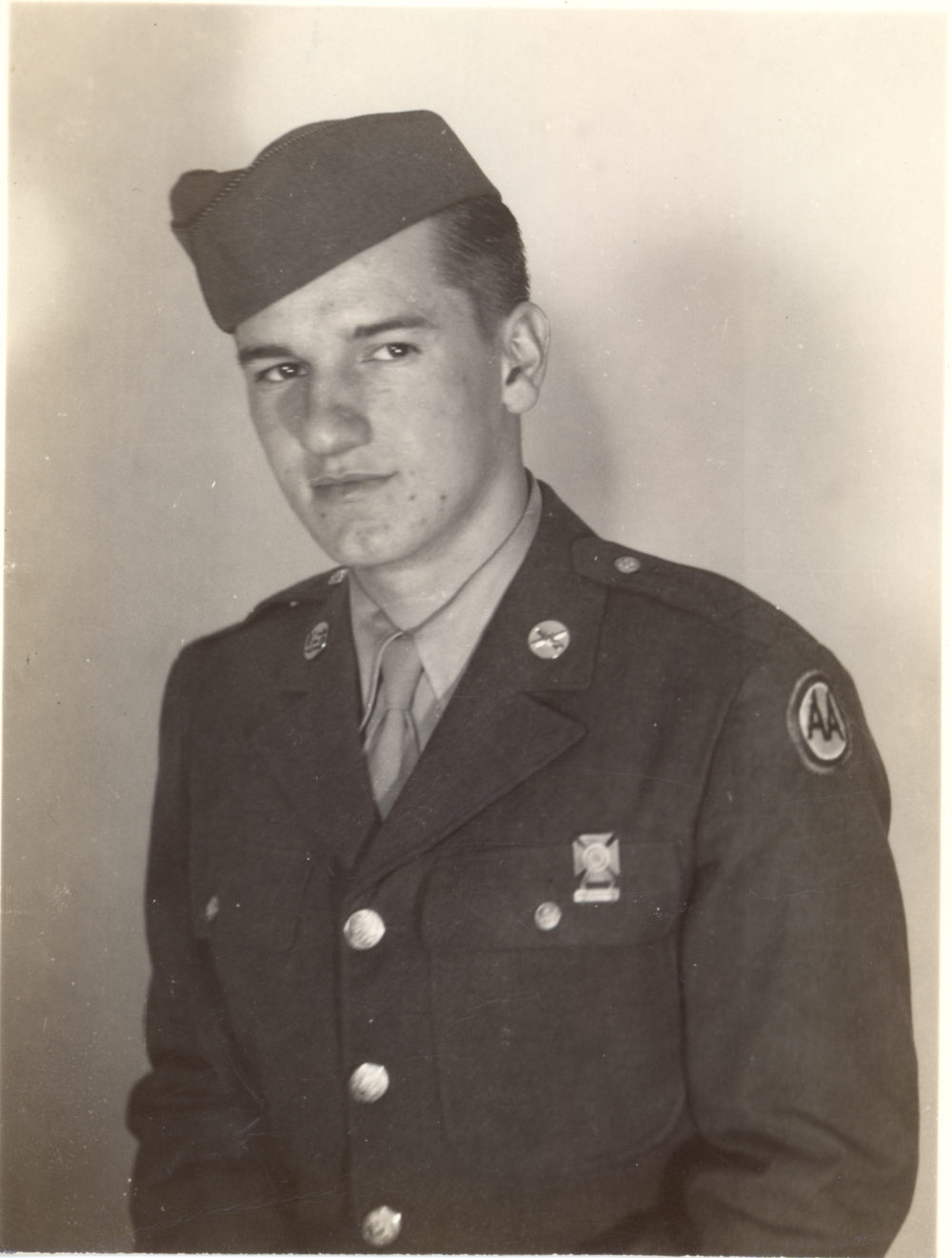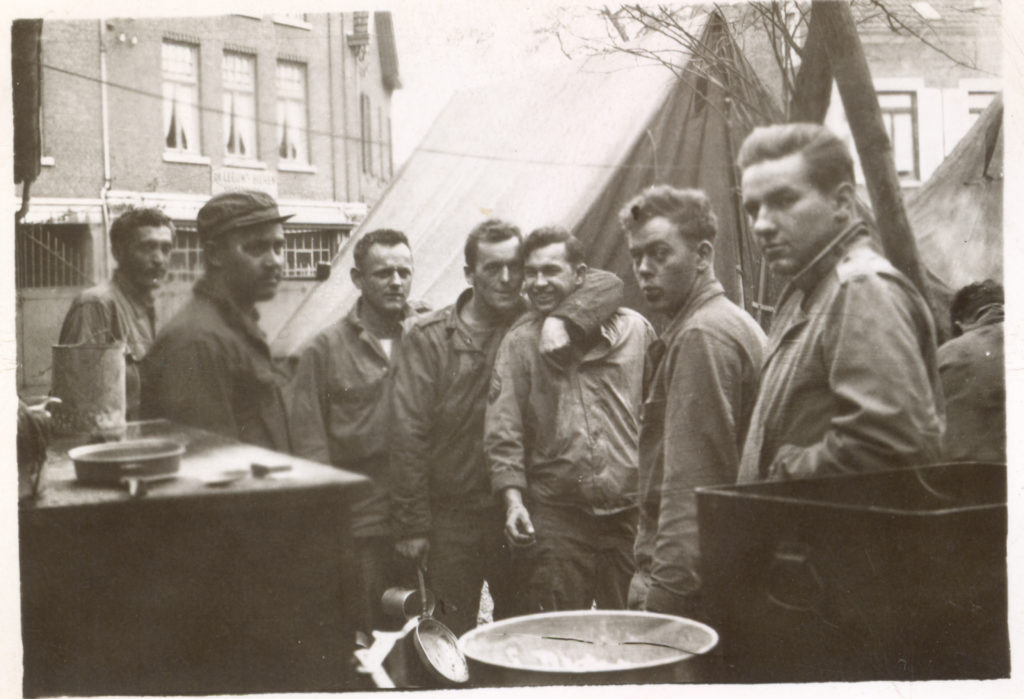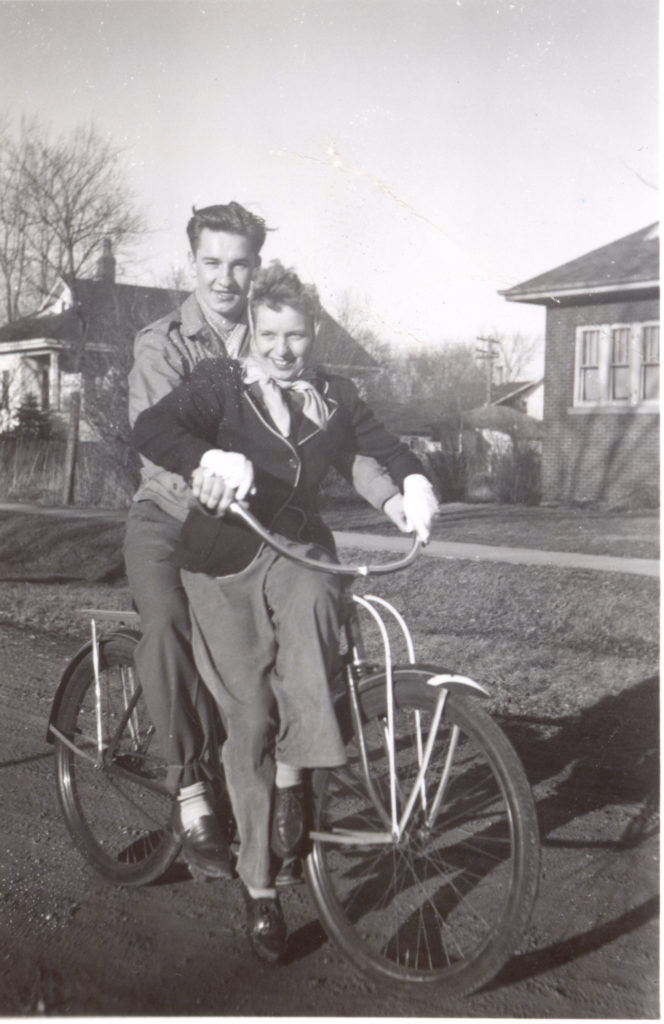Staff Sergeant Bertram Frederick Heuer, Jr.

- Unit: 9th Army, 3508th Medium Automotive Maintenance Company
- Date of Birth: August 8, 1924
- Entered the Military: February 20, 1943
- Date of Death: February 22, 2007
- Hometown: Homewood, Illinois
- Cemetery: Section C4-87 Row B Site 1. Abraham Lincoln National Cemetery in Elwood, Illinois
Von Steuben High School
2017–2018
Before the War
Bertram (Bert) Heuer, Jr. was raised in Homewood, Illinois, a small town south of Chicago. He lived with his parents, Bertram, Sr. and Rose, and his sisters, Lolita, Rose, and Elizabeth. His father was a World War I veteran and an auto mechanic.
Bert spent time in his father’s auto repair shop and learned to drive when he was eight years old. After it became a law to be a licensed driver, Heuer received an official driver’s license when he was 15. Bert remembered visiting the World’s Fair in Chicago in 1933. He witnessed the arrival of the Italian Armada in Chicago which included Italo Balbo, a fascist supporter of Benito Mussolini. Bert did not know at the time that he would later fight against fascist forces in Europe.
Despite the hardships of the Great Depression, Bert had a happy childhood with siblings and friends. He played at a nearby park, ate ice cream from The Cone Shop in Homewood, and spent time near Lake Michigan during the summer months. During high school, he saved money and bought a bicycle. He rode at night past nearby engine factories when he could not sleep. During World War II, these factories were repurposed to produce military equipment.
Military Experience
On February 20, 1943, Bertram Heuer, Jr. was inducted into the U.S. Army. He attended basic training in La Jolla, California, and was transferred to the University of Oklahoma in Norman, Oklahoma for the Army Specialized Training Program (ASTP). Later he was sent to Camp Walters in Texas to join an Infantry Casualty Replacement Battalion.
Heuer was assigned to the 3508th Medium Automotive Maintenance Company, perhaps because of his experience with cars in his father’s shop. His company left for overseas duty in February 1944 on a Merchant Marine ship from Boston. Eventually Heuer and his company arrived at Ross in Wye in southern England and waited there until June 1944.
During his time in England, Bert worked kitchen duty and post exchange duty, providing tax free goods. Eventually he and his company were called to leave for Europe. The 3508th Medium Automotive Maintenance Company maintained small arms and motorized vehicles for front line soldiers. He crossed the English Channel and landed at Utah Beach days after the initial invasion. Bert described seeing sunken ships and using makeshift ramps to bring equipment to land.
The 3508th Medium Automotive Maintenance Company followed General George Patton’s Third Army to maintain vehicles. Bert lived through air raids, witnessed the confusion of soldiers in battle, and saw soldiers get wounded, but he did not shoot a weapon during his time in the war. He remembered driving through Paris while the newly liberated French people lined the streets in appreciation. His company cleared the streets of destroyed German military equipment so that other vehicles could pass through. During this time, Bert was promoted to corporal for fixing a broken piece of equipment that others of higher rank had tried and failed to repair.
The 3508th Medium Automotive Maintenance Company moved through northern France, where they temporarily guarded a former concentration camp, and continued through Belgium, Luxembourg, and the Netherlands. In September 1944, the company moved from the Third Army to the Ninth Army.
Heuer was promoted to sergeant in December 1944 right before the Battle of the Bulge. Bert temporarily served as bugler, as his father had done in World War I. His son remembered that his dad told stories of enlisted men throwing shoes and other objects at him when he played the bugle in the morning because they wanted more sleep.
At the Battle of the Bulge, his unit received the Award of Meritorious Service unit plaque for consistent superior service. After the battle, the 3508th Medium Automotive Maintenance Company was stationed in different German towns for vehicle maintenance, but it became increasingly clear that the war would soon end. Heuer learned of the end of the war in Europe on May 9, 1945 and that an armistice had been signed in Reims, France two days earlier.
Heuer was disappointed to be assigned to service in Japan. He was short a few points to be sent home, but he ended up not having to go. He was discharged from Fort Sheridan, Illinois in December 1945. He served a total of 33 months.



Veteran Experience
During the war, Heuer received a letter from a young girl named Elfrieda Rahn (called Tootie by her friends and family). Tootie had been asked by a friend to write to a lonely soldier on the front and she complied. She wrote many letters during the war to different soldiers because it was seen as patriotic to keep up their spirits.
Tootie worked in the Grounds Department at the University of Chicago as a secretary during the war. She took notes and attended meetings about physical changes to the West Stands of Stagg Field in preparation for the first nuclear reaction on December 2, 1942. She received a private tour of the unrestricted area with other office workers, but did not know the full extent of the project until later.
After Tootie’s initial letter to Bert, they started a correspondence that lasted until he returned from the war. They went on their first date feeling like they knew each other and their relationship quickly grew. They became engaged in February 1946, just months after their first in-person meeting.
When Heuer returned home, he took advantage of the G.I. Bill and entered junior college. He was talented in carpentry and building and eventually got a job with Illinois Bell Telephone Company. He spent the rest of his career in this field of work. Bert and Tootie had three sons and lived in the south suburbs of Chicago.



Commemoration
Staff Sergeant Heuer did not fire a weapon in World War II, but he played an integral part in the Allied invasion of Europe. Starting at Utah Beach during the invasion of Normandy and following troops throughout Europe to make sure that vehicles and weapons worked properly, he and the 3508th Medium Automotive Maintenance Company played a crucial, but often overlooked role in making sure American troops were well equipped to fight.
Heuer started as a private, but was consistently promoted because of his leadership skills and technical ability. Heuer’s years in Europe during World War II affected him after his homecoming. His wife, Tootie soothed him during bad dreams and he spoke privately to his father about their war experiences. After the war, Tootie and Bert lived a peaceful life together and now they are buried together, next to Bert’s father, at Abraham Lincoln National Cemetery in Elwood, Illinois.

Bibliography
“Bertram Heuer, Jr.” National Cemetery Administration Grave Locator. Accessed September 15, 2018. https://gravelocator.cem.va.gov/index.html?cemetery=N915.
Bertram Heuer, Jr., Final Pay Voucher, National Archives and Records Administration – St. Louis.
Family Chronicles: Heuer Family. June 30, 1992. Courtesy of David Heuer and Elfrieda Heuer.

